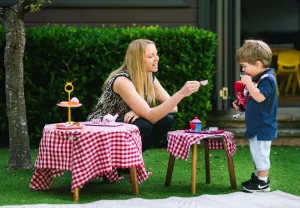Transitions for children with disability and additional needs
- Home
- Latest news
- We hear you
- Transitions for children with disability and additional needs

Tuesday 3 December is International Day of People with Disability, which highlights the importance of inclusivity. It’s a United Nations observed day that promotes community awareness, understanding and acceptance of people with disability.
International Day of People with Disability also aligns with the Disability Discrimination Act 1992 (DDA). The DDA requires that services support children with disability to access and take part in early childhood education and care in the same way as other children. Our DDA resources support approved providers, nominated supervisors, coordinators and all service staff to understand and implement their obligations.
Transitions strategies
As services start or continue their transition processes, they may like to consider Paediatric Occupational Therapist Isabella Size’s practical strategies for farewelling school leavers, welcoming new families, or supporting children moving to a new room environment.
These tips focus on regulation, connection and body movement. They are particularly valuable for teachers, educators and staff supporting families of children with disabilities or other additional needs.
1. Establish predictability and familiarity
- Arrange one-on-one orientation visits to the new room, classroom or OSHC service. Allow the child to explore their new environment at their own pace. Show the child where their belongings will go, locate the bathrooms, and role play drop-off and pick-up.
- Teachers, educators and families can use orientation visits to identify any potential barriers and consider supportive adjustments.
- On the child’s first day, try to have the familiar and known educator meet them at the point of transition.
2. Create social stories and visuals
- Encourage the new teacher or educator to take photos of key areas, spaces and learning experiences. Compile these photos into a social story that can be shared and discussed with the child in advance. This helps familiarise the child with their new learning environment.
- Encourage families to take photos during the orientation visit for discussion at home.
- Use visuals like photographs, pictures and symbols to illustrate routines and locations. This approach reduces reliance on verbal instructions.
3. Build connections with new teachers, educators and staff
- Encourage new teachers and educators to create a safe, supportive environment that promotes positive relationships and open communication with the child and their families.
- Display empathy by making statements if you can see the child is upset, rather than asking questions. This may sound like, ‘I know it’s really hard to say goodbye’ or ‘I can see you’re feeling sad about leaving’.
- Assure families that their child’s feelings are valid. Acknowledge that any feelings their child may have regarding change are okay, including feeling nervous. Additionally, inform families that non-typical behaviours may arise during this transition, and that is also okay.
4. Use consistent routines
- Keep routines consistent by using familiar cues for transitions and pack-up times. This helps the child anticipate changes throughout the day.
- Encourage teachers and educators to actively engage with the child during transitions. For example, instead of simply saying ‘5 minutes to go, time to pack up’, the teacher or educator could participate in the process alongside the child. Alternatively, a special job or brief activity could help the child prepare for the upcoming change.
5. Effective positive communication
- Use visual countdowns or timers to help the child prepare for upcoming transitions.
- Prioritise visuals over lengthy explanations to enhance the child’s understanding.
6. Implement calming techniques
- Incorporate calming strategies, such as yoga, finger breathing and online activities (like Smiling Minds). These activities help the child regulate after high energy or intense experiences.
- Experiences that encourage long exhales support children to regulate. This could be done through finger breathing, animal breaths and humming.
7. Encourage engagement before transition
- Children who need additional time to regulate may benefit from having more time and extra movement to help them transition.
- Encourage the child to take on special responsibilities, such as collecting lunchboxes or watering plants. This fosters a sense of importance and engagement. Allow the child to complete these tasks with minimum stimulation or peers present so they can transition at their own pace.
- Keep the child active and involved during transitions to help maintain focus.
8. Use body movement to support regulation and engagement
- Physical movement such as running, jumping, hopping, lifting, pulling or pushing can help children regulate. Before a transition, children may enjoy experiences such as animal walks, rolling large objects up a ramp, hopscotch or obstacle courses.
- Each child has different sensory needs to feel regulated. Be curious about each child's sensory preferences and what helps them feel regulated and engaged. For example, a child may seek out movement and have difficulty sitting still. Recognise that moving around does not mean disengagement. It is important to adjust expectations based on individual needs.
- Provide varied seating and participation options during group activities. For example, some children may focus on a story better when laying down rather than sitting cross-legged.